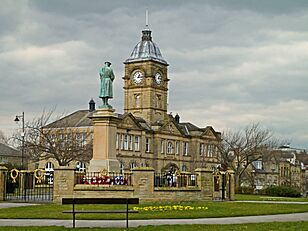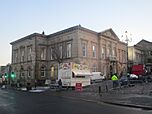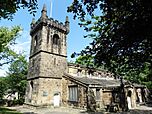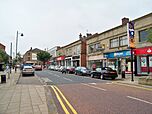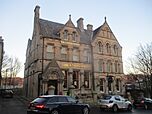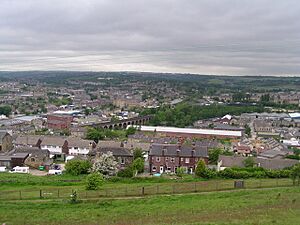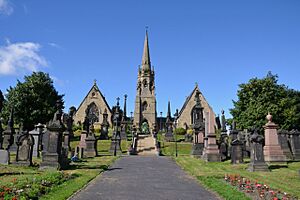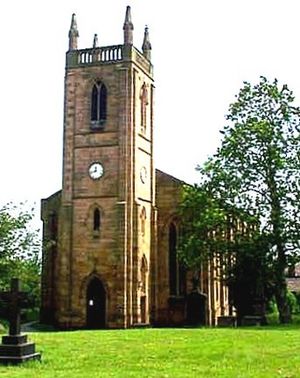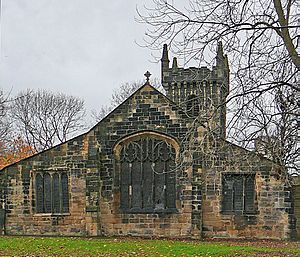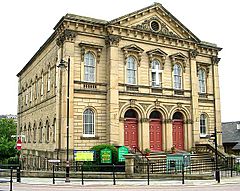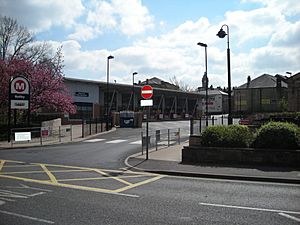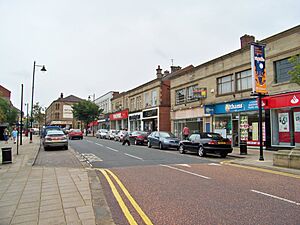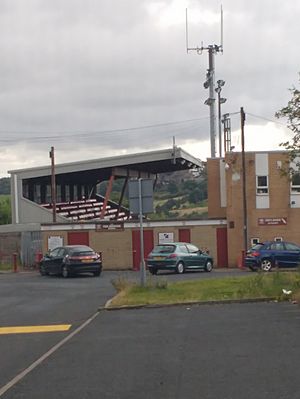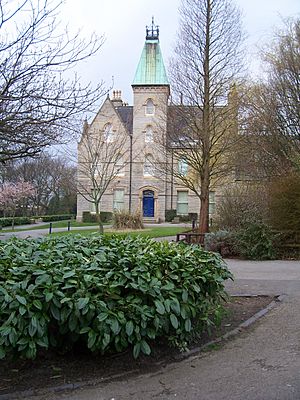Batley facts for kids
Quick facts for kids Batley |
|
|---|---|
| Town | |
|
Clockwise from top: Batley Library and War Memorial, All Saints' Church, Union Rooms on Hick Lane, Commercial Street, Town Hall |
|
| Population | 39,013 (Wards, 2021 Census) |
| OS grid reference | SE245245 |
| Metropolitan borough | |
| Metropolitan county | |
| Region | |
| Country | England |
| Sovereign state | United Kingdom |
| Post town | BATLEY |
| Postcode district | WF17 |
| Dialling code | 01924 |
| Police | West Yorkshire |
| Fire | West Yorkshire |
| Ambulance | Yorkshire |
| EU Parliament | Yorkshire and the Humber |
| UK Parliament |
|
Batley is a busy market town located in West Yorkshire, England. It's part of the Kirklees area, south-west of Leeds and north-east of Huddersfield. The town is known for being in the "Heavy Woollen District," a region famous for its textile industry. In 2011, about 48,730 people lived here.
The beautiful Batley Town Hall was built in 1854. It was paid for by local people and first used as a mechanics' institute. Batley was also home to the famous Batley Variety Club, a music venue where many well-known artists performed from 1967 onwards.
Contents
History of Batley
Early Days and Name Meaning
The name Batley comes from the Danish language. It likely means "valley of bats" or, more probably, "homestead of the Batte family," who were important locally. Batley is mentioned in the Domesday Book (a very old survey from 1086) as 'Bateleia'.
After the Normans took over England, the land was given to Elbert de Lacy. By the 12th century, it belonged to the Copley family. At this time, only about 30 to 40 people lived in Batley. By the late 1300s, the population grew to around 100.
Churches and Old Buildings
Batley has had a church since the 11th century. Batley Parish Church was built during the time of King Henry VI (1422–1461). Some parts of this original church are still standing today.
Howley Hall, a large house, was built in the 1580s by Sir John Savile. It was attacked during the English Civil War in 1643 but wasn't badly damaged. The hall was used until the 17th century but then fell apart and was taken down in 1730. You can still see some ruins today, like the cellars.
Education and Religion
Batley Grammar School was started in 1612 by Rev. William Lee. It is still an active school today.
Methodism, a type of Christianity, became very popular in Batley in the 1740s. John Nelson, a local preacher, was a key figure in this movement. Because of strong Methodist beliefs, some areas of Batley, like Mount Pleasant, had very few pubs.
Industrial Growth
In the late 1700s, most people in Batley worked in farming and weaving. The Industrial Revolution arrived in 1796 with the first water-powered mills for making cloth. Over the next 50 years, Batley's population grew quickly. It went from about 2,500 people in 1800 to 9,308 by 1851.
A new toll road was built in 1832, making it easier to transport wool, cloth, and coal. Before this, there were only footpaths and cart tracks. Around the same time, there were worker strikes in the mills. This led to many workers from Ireland moving to Batley. At first, some local people didn't like this, but over time, everyone got along better. The first Roman Catholic church, St Mary of the Angels, was built in 1870.
Modern Batley Begins
By 1848, Batley had a railway station. In 1853, Batley Town Hall was built. It was made bigger in 1905 and has a grand, classical style. In 1868, Batley officially became a municipal borough, which is a type of local government area.
Also in 1853, Michael Spedding opened a small candy shop. His business grew and became Fox's Biscuits in 1927. Today, Fox's Biscuits and Tesco are some of the biggest employers in Batley.
The "Shoddy Trade"
In the late 1800s, Batley was famous for the "shoddy trade." This was a way of recycling old wool rags and clothes by turning them into new blankets, carpets, and uniforms. In 1861, there were at least 30 shoddy mills in Batley! The people who owned these recycling businesses were called "shoddy barons." There was even a "shoddy king" and a "shoddy temple," which was actually the Zion Chapel. This impressive building opened in 1870 and showed how popular Methodism was. The chapel is still used today.
Libraries and Mining
The Batley library was built in 1907. The money for it came from a generous person named Andrew Carnegie. The library has been updated and has old copies of the Batley News newspaper, which started over 120 years ago.
People also mined coal in Batley. Records show coal mining here since the 1500s. The last coal mine in Batley closed in 1973.
Recent History
From the late 1950s, many people from Gujarat, Punjab, Pakistan, and India came to Batley. They came to work in the town's textile factories, which needed more workers.
In 1974, the local government for Batley became part of the Kirklees Metropolitan Council.
People of Batley
Since the 1950s, many people from South Asia have moved to Batley to work in the textile industry. Today, about 33% of the population in Batley West and 54% in Batley East are of South Asian background. This makes Batley a diverse and vibrant town.
Geography of Batley
Batley includes several smaller areas like Batley Carr, Carlinghow, Cross Bank, Hanging Heaton, Healey, Lamplands, Carlton Grange, Mount Pleasant, Soothill, Staincliffe, Upper Batley, and White Lee.
Some parts of Batley Carr, Hanging Heaton, and Staincliffe are also considered part of Dewsbury. Similarly, a part of White Lee is in Heckmondwike. There's also an area called Healey in Ossett, which is different from Batley's Healey.
 |
Birstall |  |
||
| Heckmondwike | Tingley | |||
| Dewsbury |
Getting Around Batley
Bus and Train Travel
Batley has a bus station in the town centre, which is managed by West Yorkshire Metro. It was rebuilt in 2005. You can catch buses from six different stands, and there are screens showing when buses will arrive. Arriva Yorkshire is the main bus company.
Batley railway station is on the Huddersfield line. This line connects Leeds and Manchester, making it easy to travel by train.
Schools in Batley
Batley Grammar School is a very old school, founded in 1612. It is still open today.
Primary Schools
- Batley Parish CE (VA) J, I and N School
- Birstall Primary Academy
- Carlinghow Princess Royal J, I and N School
- Field Lane J, I and N School
- Fieldhead Primary Academy
- Hanging Heaton CE (VC) J and I School
- Healey J, I and N School
- Hyrstmount Junior School
- Lydgate J and I School (Soothill)
- Manorfield I and N School
- Mill Lane Primary School (Hanging Heaton)
- Park Road J.I and N School
- Purlwell I and N School
- St. Mary's Catholic Primary School, Batley
- St. Patrick's Catholic Primary School, Birstall
- Staincliffe CE (VC) Junior School
- Warwick Road J.I and N School
- Windmill Primary School
Secondary Schools
- Batley Girls' High School, which used to be a Visual Arts College
- Cambridge Street School, a Muslim Boys School
- Batley Grammar School, founded in 1612
- Upper Batley High School, which used to be Batley High School for Boys, founded in 1959
Alternative Education
- Engage Academy (a Pupil Referral Unit)
Famous Places in Batley
Some well-known places in Batley include Oakwell Hall, Bagshaw Museum, Wilton Park, Mount Pleasant stadium, and All Saints Church. All Saints Church is a very important historical building.
Sports in Batley
Batley is home to the professional rugby league team, Batley RLFC. There's also a junior football club called Batley Juniors F.C.
For cricket fans, Batley has several local teams. The town is also part of the cricket association for the Heavy Woollen District. This area was originally defined as being within 6 miles of Batley Town Hall.
The Mount Cricket Club plays at Staincliffe and is part of the Halifax Cricket League.
Culture and Fun in Batley
Parks and Museums
Wilton Park (also known as Batley Park) is a large park located between the town centre and Birstall. Inside the park, you'll find the Milner K. Ford Observatory, which was built in 1966. It's home to the Batley & Spenborough Astronomical Society, where you can learn about stars and planets.
The park also has the Bagshaw Museum. This museum is in a house that belonged to George Sheard, one of the "shoddy barons." It shows local history, natural history, interesting items from around the world, and even an Ancient Egyptian exhibit. The museum is named after its first manager, Walter Bagshaw.
The Yorkshire Motor Museum used to be in Batley, showing off a collection of cars from 1885 onwards. It closed in 2010.
You can also visit the Batley Art Gallery, which is inside the Batley Library building. It displays modern art, crafts, and photography.
Entertainment Venues
Between 1966 and 1977, the Batley Variety Club was a very popular place. Many famous musicians performed there, including Louis Armstrong, Johnny Mathis, Eartha Kitt, the Bee Gees, Roy Orbison, the Hollies, and Cliff Richard. Later, it became the Frontier nightclub. It was sold in 2005 and continued as a nightclub, also hosting boxing and snooker events. The Frontier closed in 2016 and is now a gym.
A dramatic society, the "Batley Amateur Thespian Society," was started in 1913. They put on plays to raise money for the local hospital.
Media in Batley
You can watch local news and TV shows from BBC Yorkshire and ITV Yorkshire. These signals come from the Emley Moor transmitter.
Local radio stations include BBC Radio Leeds, Heart Yorkshire, Capital Yorkshire, Hits Radio West Yorkshire, Greatest Hits Radio West Yorkshire, and Rhubarb Radio.
The local newspaper for Batley is the Dewsbury Reporter.
Famous People from Batley
Many interesting people have come from Batley:
- Joseph Priestley (1733–1804) – A famous chemist who discovered oxygen. He was educated at Batley Grammar School.
- William Henry Colbeck (1823–1901) – A politician in New Zealand.
- Titus Sheard (1841–1904) – An American businessman and politician.
- Theodore Taylor (1850–1952) – A businessman and politician known for sharing profits with his workers.
- Louis Hall (1852–1915) – A cricketer for Yorkshire County Cricket Club.
- Joseph Cookman (1899–1944) – An American journalist.
- Hugh Garner (1913–1979) – A Canadian novelist.
- Robert G. Edwards (1925–2013) – A physiologist who won a Nobel Prize for helping develop in-vitro fertilisation (IVF).
- Leslie V. Woodcock (born 1945) – A professor of chemical thermodynamics at the University of Manchester.
- Robert Palmer (1949–2003) – A pop singer famous for his song "Addicted to Love".
- Arthur Roche (born 1950) – An archbishop who was the Bishop of Leeds before working for the Pope in Rome.
- Larry Hirst (born 1951) – The chairman of IBM Europe, Middle East, and Africa.
- Tracy Brabin (born 1961) – The first Mayor of West Yorkshire and a former Member of Parliament for Batley & Spen.
- Mark Eastwood (born 1971) – A politician and Member of Parliament for Dewsbury.
- Jo Cox (1974–2016) – A politician and former Member of Parliament for Batley & Spen.
- Kim Leadbeater (born 1976) – A politician and current Member of Parliament for Batley & Spen.
Images for kids
See also
 In Spanish: Batley para niños
In Spanish: Batley para niños


